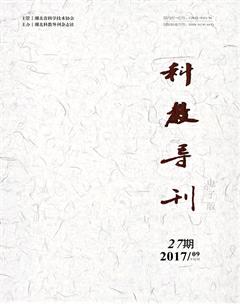国际化视野下博物馆展品解说词的英译研究
孟艳
摘 要 文物是人類文化的珍贵遗产,博物馆是人类历史文化的宝库。从国际化语境下对博物馆文物展览解说词翻译进行理论和实践两方面研究具有积极的现实意义,本文拟从天津博物馆藏品解说词英译进行理论与实践两方面研究,进而推进全市博物馆文物展示整体水平。
关键词 博物馆展品解说词 翻译研究 天津博物馆
中图分类号:H315.9 文献标识码:A
1项目研究背景
博物馆是人类历史灿烂文化的宝库,从1682年诞生以来就一直承担着传承文化、记忆历史的重任。为了更好地向世界介绍中国的悠久历史文化,让全世界更好地了解中国,中国的博物馆文物展品解说词英译是必不可少的历史需求,在跨文化传播中发挥着愈来愈重要的作用。为满足这一需求,我国很多博物馆都对展品使用英汉两种文本加以介绍,一些英文版的博物馆相关书籍也得以出版发行。
现在,中国很多博物馆的文物名称都配有英文翻译,既方便了外国游客参观,同时也成为向他们介绍和传播中国历史文化的重要手段。但由于中英文两种语言在语言体系、文字系统及思维方式等方面存在诸多差异,因此,中国博物馆翻译,不能仅仅以传统的等值翻译作为翻译的标准。“文物名称的作用是向读者传达信息,是一种将文化信息公示给读者的文本,因此,就文本作用来看,它类似于街道名称或公共标识等公示语。”在公示语功能特色和语言风格的基础上,刘法公根据文本类型提出“公示语翻译应该遵循统一、简洁和易懂性三原则。”
2研究途径
此研究从国际化语境下对博物馆展品解说词翻译进行理论和实践两方面研究。目前天津市共有20多家各种规模的博物馆,规模比较大的博物馆包括天津博物馆、天津市元明清天妃宫遗址博物馆、天津自然博物馆、天津戏曲博物馆、天津金融博物馆、天津邮政博物馆、天津文庙博物馆、北疆博物馆、石家大院(杨柳青博物馆)等,但是目前已经上线的天津市各类博物馆官方网站上的英语版介绍主页信息均空缺,通过此项研究的开展对于天津市各类博物馆对外宣传交流的文化传播能力提升会起到积极促进作用。计划对天津市各类博物馆所展览的文物英文翻译进行分析和研究,通过实地走访和考察对目前文物展览解说词英文翻译进行分析、评估和修改。在翻译过程中主要借鉴功能翻译主义理论对博物馆文物英文介绍进行研究和分析。
3实践过程
本项目通过馆藏文物解说词的英译进行具体实践。目前已经取得书画部分展品解说词英译的阶段性成果。如:
3.1明 仇英 桃源仙境图轴
Hanging Scroll of Fairyland of Peach-Blossom Spring, by Qiu Ying in Ming Dynasty?
一提到“桃源仙境”,大家一定会联想到东晋隐士陶渊明所写的《桃花源记》,它描绘了人们理想中的隐居圣地,而仇英的这幅《桃源仙境图》描绘的也正是文人雅士心目中的隐居之地。仇英是明代非常具有代表性的画家之一,他家境贫寒,出身工匠,因擅长画画结识了当时许多的文人雅士,并与沈周、文征明和唐伯虎被后世并称为“明四家”,也称“吴门四家”。他曾拜在唐伯虎的老师周臣门下学画。仇英早、中期是以临摹为主,到了晚年将大青绿山水画推向了一个新的高峰,这幅《桃源仙境图》就为重彩大青绿山水,图中山石矗立,虬松盘绕,图的下方有三位隐士临流而坐,一人乘兴抚琴,桥下溪水清澈,坡上桃树林掩映于山石、树木之间。白色的文人衣着在金碧辉煌的山石、林木映衬下,显得格外鲜明。图中的山峰画法以石青为主,石绿辅之,展现出远离世俗、虚幻飘渺的人间仙境,构图取北宋全景式大山大水的布局特征,视野开阔清旷,境界宏大,疏密比对强烈。所绘山水气象万千,人物生动传神,它与仇英的另一幅传世名作《玉洞仙源图》被合称为“双美图”,是仇英被公认的晚年传世两幅最好的作品。《玉洞仙源图》现藏于北京故宫博物院,而这幅《桃源仙境图》右下属款“仇英实父制”,钤“仇英实父”一印。画上另有“乾隆御览之宝”、“石渠宝笈”两方清内府藏印,并有“灵石杨氏珍藏”、“杨曾之印”、“燕翼堂”、“颍川怀云子图画”等鉴藏印,(这幅画的上款“怀云”为明代苏州的大地主陈观),标明这幅图卷流传有序,曾被明代陈怀云和清代安岐鉴藏,并曾入藏清乾隆内府,后被清代工部侍郎张翼收藏,而后由张翼的儿子张叔诚先生在1981年捐赠给国家。
Speaking of the “Fairyland of Peach-Blossom Spring”, people would think of the well-known essay “Peach-Blossom Spring” written by the eremite TAO Yuanming of the Eastern Jin Dynasty (317-420). It depicts the Holy Land for living in seclusion, which is exactly the literati and refined scholars pursue in this painting. QIU Ying is one of the most representative painters of Ming Dynasty since he came from a poverty-stricken family, used to be a craftsman and got acquainted with lots of literati and refined scholars thanks to his talents in painting. He together with SHEN Zhou, WEN Zhengming and TANG Bohu is known as “the four masters of Ming Dynasty” which is also referred as “the four masters of Wu School”. He once learned from TANG Bohus teacher-ZHOU Chen. He concentrated on coping in his early and middle course and pushed the dark green landscape painting to a new height in his later years. This artwork is such heavy-colour dark green painting of landscape. The mountain stones stand upright; the pine trees twine like dragons; at the bottom are three eremites sitting beside the stream, one of whom is playing the zither while he is in high spirit; there is a bridge not far from them, below which the stream is clear; on the slope, the peach-blossom trees nestle among the mountain stones and pines trees. The splendid and magnificent mountain stones and trees throw the white-clothing literati into bright scene. The color applying of this painting takes the mineral blue as the principal color, supplemented by the mineral green. By doing so, the scene of imaginary and ethereal fairyland on earth where one can live far away from the secular world is presented. The composition features the panoramic view of huge mountain and vast waters of styles of Northern Song Dynasty with extensive view, grand state and sharp contrast of sparsity and density, which makes the landscape majestic and grand and the figures vivid. This painting together with his another artwork (“Fairyland in the Jade Cave”) is collectively named “Pairs of Beautiful Paintings”, which is generally acknowledged as the best artworks handed down of his later years. “Fairyland in the Jade Cave” is now collected in the Palace Museum in Beijing. On the right bottom there is the inscription of “made by QIU Ying with style name SHI Fu” and the seal of “QIU Ying with style name SHI Fu”. In addition, there are two official collection seals of imperial storehouse of Qing Dynasty-one is “oval relief” and the other is “Shiqu Baoji”. Besides, there are connoisseurship and collection seals of “collected by YANG in Lingshi County”, “Seal of Yang Zengzhi”, “Swallow Wings Hall” and Huai Yunzi (who is the squire in Ming Dynasty) in Ying Chuan”and so on, indicating this painting has been well handed down and successively collected by CHEN Huaiyun in Ming Dynasty, imperial storehouse of Qing Dynasty, and later the assistant minister of Ministry of Works in feudal China, ZHANG Yi. His son, ZHANG Shucheng donated it to our country in 1981.endprint
3.2清散秩大臣喀喇巴图鲁阿玉锡像轴
Hanging Scroll of the Portrait of Minister of Imperial Guard, Kharatsin Baturu Ayuxi in Qing Dynasty
(Manchu: baturu) is a title from the Qing Dynasty for commanders and soldiers who fight bravely in a battlefield. In Manchu, baturu means warrior or brave.
这幅图所绘的是散秩大臣喀喇巴图鲁阿玉锡的画像,这是一幅立轴像,纵185.3cm,横94.7cm。在这幅画的上方有乾隆皇帝的亲笔题赞,“格登山贼据险守,率24人间道袭后,诸贼大溃,爰以成功”,汉文、满文和御玺。而乾隆皇帝所写的内容是说阿玉锡率领了24名骑兵,乘夜幕直捣敌营,取得大胜,为平定达瓦齐叛乱立下了不朽的功勋。功臣像是由皇家画院的画师绘制,绘制之前宫廷画家先要画出草图,在乾隆皇帝御览批准之后才能正式绘制。每幅画像都画得惟妙惟肖,栩栩如生。可您仔细看一下画面,您会发现这幅画像上人物庄重威严,五官显得格外立体,表情细腻,使整个人物更加生动真实,这是因为当时西洋画师带来的西洋画法在清朝非常盛行,笔法非常的细致。您看到的这身铠甲,又叫“锁子甲”,是一种软铠甲,铠甲上是环环相扣的,非常精细,铠甲里的花纹也是清晰可见的,裙摆上的花纹像是绣上去的一样。
This painting is the portrait of Minister of Imperial Guard, Kharatsin Baturu Ayuxi in Qing Dynasty. It is a hanging scroll with the height of 185.3cm and the width of 94.7. On the top is the inscription by Emperor Qianlong of his own handwriting in both Chinese and Mongolian and the Great Seal. To put briefly, the meaning of the scripts is that Ayuxi commanded 24 cavalrymen to directly attack the enemy camp when the night fell and won a landslide victory, making a great triumphant in putting down the rebellion of minority group Davatchi. Portraits of persons who have rendered outstanding service to Qing Dynasty were draw by the painters of royal art academy. They should make a draft first and have it checked by the emperor Qianlong. Only if they got the approval can they start to formally compose it. You can see every painting is lifelike and vivid. If you observe it carefully, you can see that the figure is solemn and dignified and the features appear to be three-dimensional with delicate expression, which makes the figure lifelike. That is the result of the popularity of western painting skills in Qing Dynasty brought in by the western painters whose techniques of painting are meticulous. The armor on the person is also called chain-armor or mail. It is of soft quality and the parts are all lined with one another with exquisite composition. The decorative design is clearly visible and the patterns on the pepla are seemed to be embroidered.
參考文献
[1] 王娟萍.全球化语境下中国博物馆翻译策略研究——以中国丝绸博物馆为例[J].湖北函授大学学报,2012(04).
[2] 郦青,胡雪英.博物馆文物展品英译研究——以浙江省博物馆为例[J].中国科技翻译,2011(03).
[3] 王建荣,郭海云,孙倩.文化预设视角下的文物英译策略研究[J].东岳论丛,2010(06).
[4] 建荣,郭海云.文化软实力视阈下文物文化对外传播策略分析——以博物馆语境为例[J].北京交通大学学报(社会科学版),2010(02).endprint

